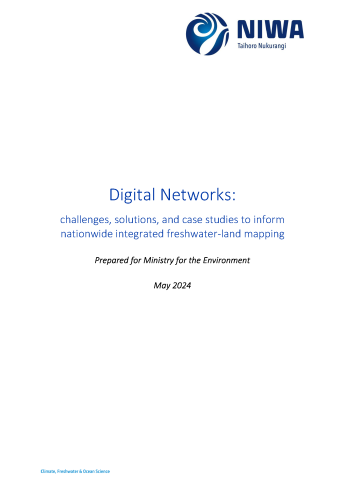Digital networks (DNs) and their derivative, the River Environment Classification (REC) system, are two of New Zealand’s foremost resource management tools. These tools form a spatial framework for environmental modelling, reporting, assessment and management that covers the country’s 425 million kilometres of river network. They were developed by the National Institute for Water and Atmosphere Research (NIWA) and funded in part by the Ministry for the Environment.
DNs allow spatial representation of surface flow pathways, including their direction, network connections and associations with surrounding land. The REC is calculated from the DNs and is used for regional and central authority resource management. River segments are classified based on climate, topography, geology and land-cover factors and improvements to the DN data adjusts the accuracy of the assignments, which in turn helps government or regional authorities effectively manage their rivers.
The Ministry commissioned NIWA to conduct a pilot study in two catchments (Te Waihora | Lake Ellesmere and Te Awa o Mokotūāraro) to research and determine the best way to ensure an accurate, effective and user-friendly DN and REC toolset according to user feedback. The report shows the potential for a national-scale update to the DNs and REC that would provide greater detail and higher accuracy in flatter areas or on engineered waterways, which would greatly improve central and local government’s ability to resource manage rivers and catchment areas.
Digital networks (DNs) and their derivative, the River Environment Classification (REC) system, are two of New Zealand’s foremost resource management tools. These tools form a spatial framework for environmental modelling, reporting, assessment and management that covers the country’s 425 million kilometres of river network. They were developed by the National Institute for Water and Atmosphere Research (NIWA) and funded in part by the Ministry for the Environment.
DNs allow spatial representation of surface flow pathways, including their direction, network connections and associations with surrounding land. The REC is calculated from the DNs and is used for regional and central authority resource management. River segments are classified based on climate, topography, geology and land-cover factors and improvements to the DN data adjusts the accuracy of the assignments, which in turn helps government or regional authorities effectively manage their rivers.
The Ministry commissioned NIWA to conduct a pilot study in two catchments (Te Waihora | Lake Ellesmere and Te Awa o Mokotūāraro) to research and determine the best way to ensure an accurate, effective and user-friendly DN and REC toolset according to user feedback. The report shows the potential for a national-scale update to the DNs and REC that would provide greater detail and higher accuracy in flatter areas or on engineered waterways, which would greatly improve central and local government’s ability to resource manage rivers and catchment areas.
